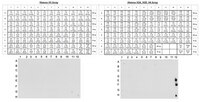Free and chromatin-associated mono-, di-, and trimethylation of histone H4-lysine 20 during development and cell cycle progression.
Karachentsev, Dmitry, et al.
Dev. Biol., 304: 46-52 (2007)
2007
Show Abstract
Methylation of specific amino acids in histone tails is responsible for packaging DNA into condensed, repressed chromatin, and into open chromatin that is accessible to the transcription machinery. Monomethylation and trimethylation of histone H4-lysine 20 (H4-K20) control the formation of repressed chromatin. Using antibodies that specifically recognize the three methyl marks of histone H4-K20, we characterized their regulation during the cell cycle and throughout development. We find free mono- and trimethylated histone H4-K20 in unfertilized Drosophila eggs and in S2 tissue culture cells. Soluble mono-. di-, and trimethylated H4-K20 are also found in HeLa cells. These soluble modified histones may represent a pool of free histones that can rapidly be incorporated into chromatin. The three methyl marks are each regulated differentially during development and their detection on western blots does not overlap with their detection on chromosomes. Monomethylated H4-K20 is detected on condensed chromosomes throughout development, while di- and trimethylated H4-K20 are detected on metaphase chromosomes at specific stages. Our results suggest that the detection of methylated H4-K20 on chromosomes may reveal chromatin packaging rather than the distribution of the methyl marks. | 17229421
 |










